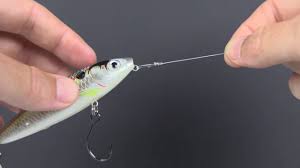How to Tie a Fishing Lure?
What is a fishing lure?

How to tie a fishing lure?
How do you tie a fishing lure to the main line?
How To Tie The Palomar
- Double about six inches of the main line and run it through the hook eye.
- Double the loop back and make an overhand knot around the doubled line, leaving a loop large enough to pass the hook or lure through.
- Pull the loop down and around the entire hook or lure.
Or
- Tie an overhand knot six inches down the end of the line. Thread the line through the lure and then through the loop in the knot. Make three wraps around the line and then pass the end through the loop again. Run the end through the new loop and pull tight.
How to tie a lure on a fishing line?
The Palomar Knot
This is as simple as fishing knots can get. Basically, you're just tying an overhand knot with a small loop through the eye of the hook and then taking the hook back through the loop. Snip the tag end of the line and you're done.
. Improved Clinch Knot
This is the simple knot I use myself for almost every fishing application. It couldn't be easier to do. You're just running one end through the eye of the hook or lure, looping it a few times and then looping that tag end back through the loop again. Pull it tight and clip the tag end and you're ready to fish.
Trilene Knot
This knot goes by a few different names. You may hear someone refer to this as the "clinch knot" or "double clinch knot," but they're all the same thing.
These are good "catch all" knots
There many other types of knots out there, and a growing numbers of types of fishing line, too. The Surgeon's knot, the snell knot, the rapala knot and the uni knot to name a few. But the three we've outlined here are good ones to know because they'll work for just about any fishing situation, not just artificial lures.
What is a fishing lure?
Fishing lures are small, artificial objects often shaped like a fish's prey that are attached to a hook and tied to the end of a fishing line. They are used to attract fish to your line. There are many different types of lures on the market such as jigs, spinners, spoons, fly lures, crankbaits, and plugs.
How are fishing lures made? www.lewdoglures.com
We use high quality blanks, Lifelike wraps, VMC Hooks, Stainless heavy rings and Countertop grade epoxy in every lure.
We assemble beautiful fishing lures that don’t just look great in your tackle box but look great to the fish, too! All of our fishing lures are wrapped in a real fish picture to look as lifelike as possible. Fish find them irresistible!
How to use a fishing lure?
Lures are usually used with a fishing rod and reel and can be bought commercially or made by hand. They're typically made out of materials such as plastic, cork, rubber, wood, or metal and sometimes have feathers or tinsel attached to them to resemble the moving parts of fish prey, as is the case in fly fishing flies.
How to fish with lures?
Cast your lure and point the tip of the fishing rod towards the water. You should begin by moving the rod slowly before gradually increasing the speed to mimic the movement of an escaping prey. The idea here is to convince your targeted fish that the lure is an actual prey trying swimming for safety.
Is it better to fish with bait or lures?
Many species of fish are much less responsive to lures than they are to bait. Lure fishing generally demands better-quality tackle and a higher degree of skill than bait fishing. Lure collecting can become at least as addictive (and expensive) as lure fishing.
Here at Lew Dog Lures, we are avid fisherman attempting to make the most realistic lures around. We decided the best way to accomplish this would be to attach a picture of a real fish to lures we love to use. Pleases check out our store www.lewdoglures/store

